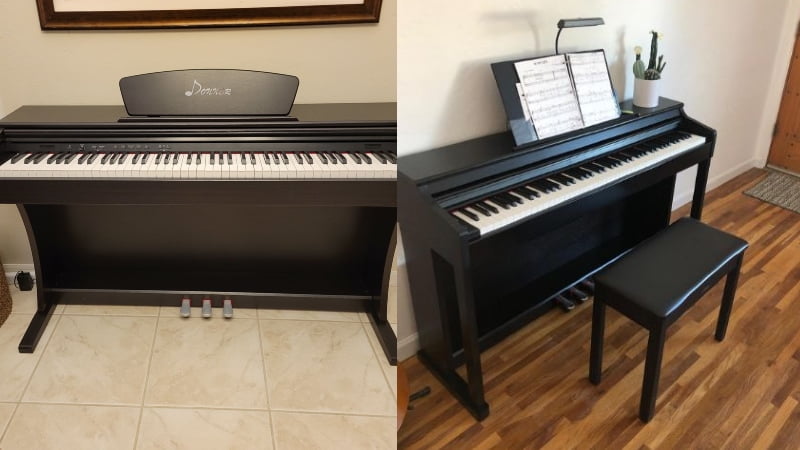The Donner DDP-300 is one of the most popular console digital pianos out there. It’s relatively affordable, comes with great tones, and is also the brand’s flagship console digital piano. However, there’s much debate as to whether or not the cheaper Donner DDP-100 can hold its own against the flagship model.
That’s why I made this Donner DDP 100 vs 300 comparison, to get to the bottom of the debate. And in the end, I found that the Donner DDP-100 puts up a great fight against the more expensive option.
While the Donner DDP-300 won out with its varied voice selections, better feel, and more playing modes than the DDP-100, I was actually surprised at how close of a fight it was. This is because despite the lower price point, the Donner DDP-100 also comes with great features that makes it a great choice for just about any beginner pianist out there.
Donner DDP 100 vs 300: Comparison Chart




Last update on 2024-07-25 / Affiliate links / Images from Amazon Product Advertising API
Donner DDP 100 vs 300: The Differences
While both of these models come from the same line and brand, they also have a fair amount of differences. So, to find out the winner in this Donner DDP-100 vs 300 comparison, I decided to compare each of the pianos’ features against one another. And in the end, the final score was 4-1 in favor of the DDP-300.
But don’t let the scoreline fool you, the fight was actually much closer than you might expect since both pianos come with a great set of different features making them ideal for any beginner and novice pianist out there.
Tone
The winner: Donner DDP-300
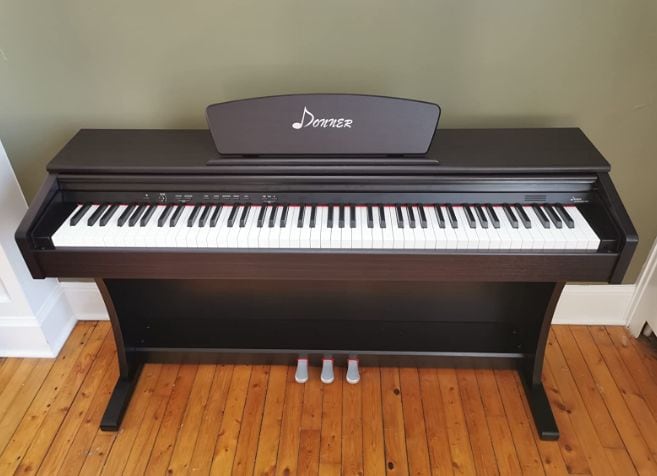
A key feature of both the Donner DDP-100 and 300 is the fact that they use the AWM sampling method originally created for Yamaha digital pianos. The result is a rich and bright piano tone on both instruments. But in the end, the Donner DDP-300 eventually beat out the DDP-100 because of its versatile set of different tones and voices.
+ Tone Generation
As mentioned earlier, both of these models use the AWM sampling method. Originally developed for Yamaha pianos, this method isn’t too different from the traditional sampling method and works in the same general way. Whenever you press a key on either of these pianos, the keyboard will play a sample recorded for a real instrument.
However, most budget-friendly digital pianos use low-quality recordings with digital decay. While this results in a less accurate tone, it does make the piano more affordable by saving on memory. However, with the AWM sampling method, Donner doesn’t skimp on memory to provide players with an incredibly rich and bright set of tones.
When using AWM sampling, the piano stores high-quality stereo samples recorded with natural decay. While the differences are subtle, they are very important in creating a very accurate and rich piano tone. And after testing both pianos out by ear, I found that they easily beat out a lot of other models in their price range.
+ Sound Library
So, if the Donner DDP-300 and the DDP-100 use the same tone generation method, why is the DDP-300 the winner?
The reason is its varied sound library.
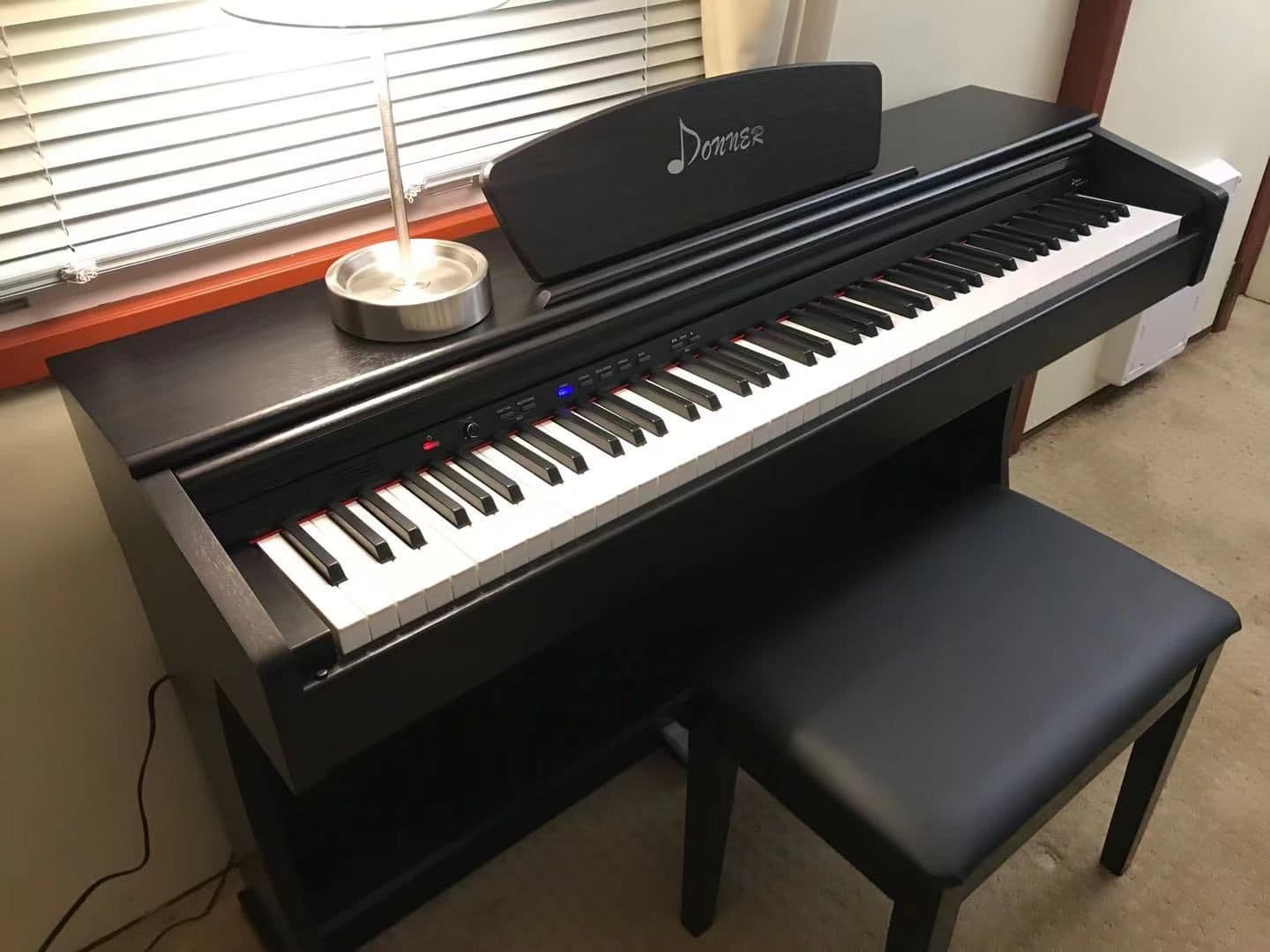
On the DDP-100, you only get one piano tone. While this is fairly limiting, this might be a good feature for beginners. Since you only have one voice, you won’t get distracted and end up playing around with other sounds. On top of that, since the piano only has one tone, Donner was able to keep a close eye on its development and the result is one of the most realistic piano tones in its price range.
On the other hand, the DDP-300 has 10 different voices. And since it’s the flagship model of the DDP collection, it still has the great, rich piano tone of the DDP-100. But on top of that, it has a variety of electric piano, synth, strings, and bass tones. If you’re a beginner, you might not need all of these different tones, but it’s always nice to have that variety and room for experimentation.
Feel & Playability
The winner: Donner DDP-300
In terms of feel and playability, the Donner DDP-300 is the winner solely because of the GHS hammer action system developed by Yamaha. Since it’s more expensive, you’d expect it to have a better and more sophisticated hammer action system, though admittedly, the Donner DDP-100 was close behind in this comparison.
+ Hammer Action
The Donner DDP-100 features traditional progressive hammer action. This is better than regular fully-weighted keys as the keys on the left side will be a bit heavier than the keys on the right side. This provides a more realistic feel that mimics the sensation of playing a real acoustic piano. And in fact, I’d have to say that the feel of the DDP-100 beats out just about any other piano in its price range.
However, the Donner DDP-300 comes with the lauded GHS system. GHS stands for Graded Hammer-action System, which was also developed for Yamaha pianos. It takes the same principles of progressive hammer action, but employs more sophisticated technology to mimic the feel of a real acoustic piano.
With that said, the difference is minimal. While there’s no denying that the DDP-300 has better and more realistic hammer action than the DDP-100, most beginners won’t be able to tell the difference anyway. But the longer you plan the instrument and the more you familiarize yourself with the acoustic piano, the more glaring the difference becomes.
+ Key Texture
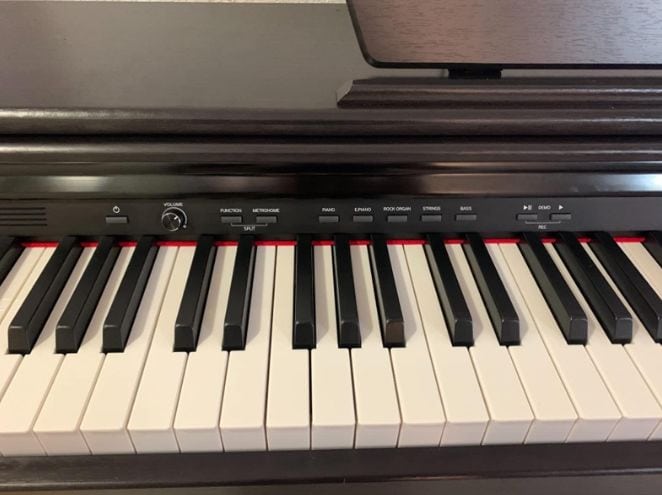
When it comes to key texture, I would have to say these pianos are tied. And depending on how you look at it, this could even be a point in the DDP-100’s favor. The reason I say this is that despite the DDP-100 being much more affordable than the DDP-300, both pianos feature the same key texture, which is a slight letdown on the side of the DDP-300.
Neither of these pianos have any coating on their plastic keys. So, you won’t get the same texture or feel of an acoustic piano. Most digital console pianos use a synthetic ebony and ivory material for their keys. However, the DDP-100 and DDP-300 only use plastic keys.
The result is a glossy finish and very slippery feel. Granted, these keys still had more grip than other uncoated plastic keys like on the Yamaha P45. However, when you become an experienced pianist, this plastic texture could hinder your playing, which can sometimes result in pianists needing to upgrade their instrument.
Piano Features
The winner: Donner DDP-300
In terms of the piano features, there was almost no contest between the two. In almost every category, the flagship DDP-300 model beat out the DDP-100. So, when it came down to the piano features, the DDP-300 was the easy winner and it’s the only area where I found the DDP-100 to be lagging behind significantly.
+ Playing Modes
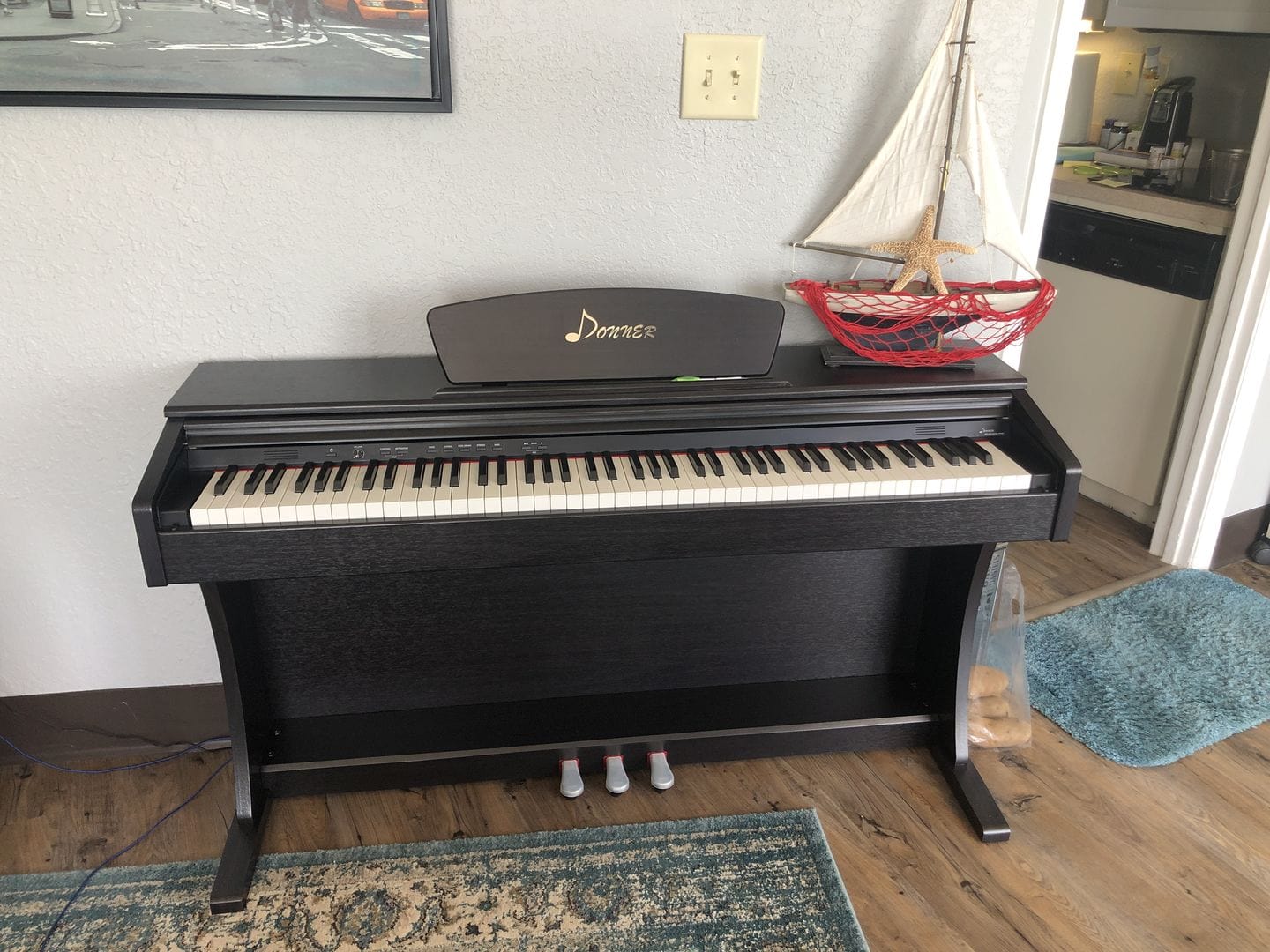
When comparing the DDP-300 to other digital pianos, you might find it lacking in terms of the different playing modes. However, when comparing it to the DDP-100, which has no additional playing modes, the DDP-300 seems like a very versatile option. The reason for this is that the DDP-300 comes with a duo-mode function. This mode has different names depending on the brand and manufacturer, but it serves the same purpose: dividing the piano into two mini keyboards with the same tuning.
The main application for this mode is during piano lessons. When you activate this mode, you and your teacher will have the exact same pitch and timbre on either side of the piano. That way, the teacher can conduct demonstrations and corrections to your techniques without having to cross over to the other side of the piano.
Along with this mode, the DDP-300 also has a metronome function and recording function. This is great for practicing as it helps you keep time. And with the recording function, you can listen back on your playing and figure out where you need to make improvements and adjustments.
+ Effects
The Donner DDP-300 doesn’t come with that many effects, but it does come with reverb, which is very important for pianists. With reverb, you can add a bunch of depth and texture to the original piano tone and give the illusion that you’re playing in a wider space like a concert hall or theater.
It would have been nice for the DDP-300 to also come with a chorus effect, but that sadly isn’t present. However, compared to the Donner DDP-100 which has no additional effects, the Donner DDP-300 offers pianists much more versatility.
+ Pedal Unit
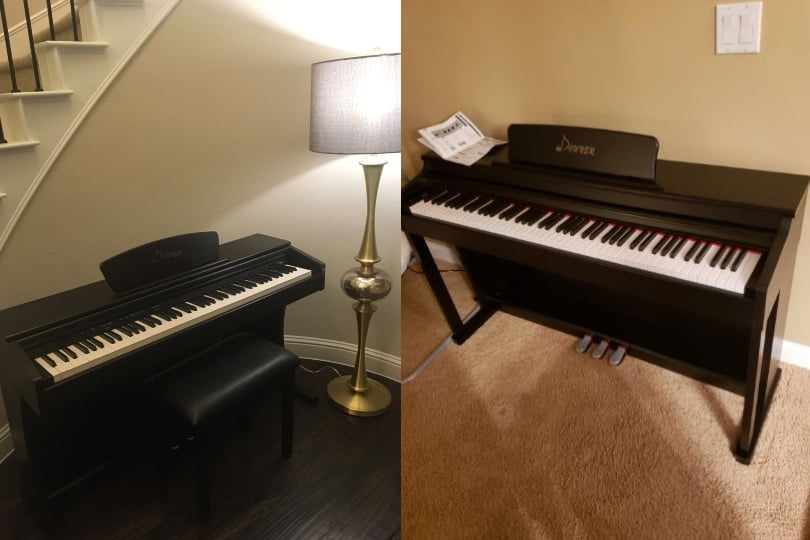
One of the primary features of both of these pianos is the pedal unit. Since these are console digital pianos, they both come with a three-pedal unit with a sustain, soft, and damper pedal. This is just like the pedals you have with an acoustic piano, and it easily beats out many other models in their price range. Most pianos in the sub-$800 range don’t feature a three-pedal unit, which is a huge point in both these pianos’ favor.
Portability
The winner: Tie
These two pianos are very much tied in terms of portability. And with these models, that actually means that they aren’t portable. These are heavy and bulky digital pianos, so once you set it up, the instrument is designed to stay in the same place for a long time. So, if you need an option for playing gigs and jamming with friends outside your home, then these aren’t the right options for you since they are both fairly heavy, bulky, and impractical to transport.
Donner DDP 100 vs 300: The Similarities
These pianos are from the same brand and the same line, so you can expect a couple of similarities here and there. For example, both models are console digital pianos with a full-key keyboard. On top of that, they both feature a three-pedal unit, progressive hammer action, and use the same tone generation method.
Both of these pianos were designed for beginners on a budget. That’s why if you look at the price tag, they are significantly more affordable than the other options with the same features. So, if you’re looking for a beginner’s digital console piano under $800, either of these pianos will serve you very well. However, it’s worth mentioning that since the DDP-300 is the flagship model, it does come with more features and versatility.
Quick Rundown of the Donner DDP-300
- 【88 Weighted Key Digital Piano】Experience the authentic touch of an acoustic piano from a digital piano. With bass keys that feel heavier and treble keys that are lighter, the DDP-300 electric piano offers a real playing sensation. A sliding keyboard cover protects players' fingers.
- 【High-Quality Sound Selection】Benefit from 10 preset high-definition timbres, sampled from premium grand pianos. Boasting 128 polyphonies, this digital piano allows for complex note combinations without dropping any sounds. Plus, with MIDI output, customize and craft your unique musical compositions. The built-in metal pedals enhance the authenticity of live performances.
- 【Premium Audio Experience】Indulge in a warm, 3D surround sound experience. With rich bass and bright trebles, our stereo system, consisting of dual tweeters and a subwoofer, provides exceptional full-range tone.
- 【Versatile Features】88 key weighted piano keyboard that connects with various external devices through interfaces like MIDI, Audio output, and Bluetooth. The partition mode splits the keyboard into two equal-pitch sections, simplifying one-on-one teaching.
- 【Suitable for Adults & Kids】The DDP-300 beginner digital piano with 88 keys full size kweboard, 4 touch curves and dual headphone jacks, enjoy uninterrupted late-night sessions without disturbing others. An ideal choice for both beginners and seasoned players.
Last update on 2024-07-25 / Affiliate links / Images from Amazon Product Advertising API
Quick Rundown of the Donner DDP-100
- Authentic Key Feel: Experience the precision of an 88-key fully-weighted action digital piano. Designed to replicate the genuine touch of traditional pianos, it captures every nuance for an enhanced playing experience.
- Meticulous Sound Engineering: Our experts have adjusted timbre details, providing a more lifelike sound that sharpens your ability to discern musical notes.
- Versatile Audio Options: An 88 key weighted keyboard with with input and playback for MP3 tracks through the built-in amplifier, whether you're using external speakers or headphones.
- Elegant Design: A sleek, streamlined piano keyboard with wooden cabinet coupled with a sliding key cover ensures your keys are always protected and your piano always looks its best.
- Unparalleled Sound Quality: The Donner DDP-100 beginner digital piano boasts pure tones sampled directly from real acoustic grand pianos, assuring the pinnacle of sound quality for both practice and performance.
Last update on 2024-07-25 / Affiliate links / Images from Amazon Product Advertising API
Product Videos
Related Articles to Donner Ddp 100
- Donner DDP-90 vs DDP-100: Which Budget Console Piano Is the Best Pick?
- Donner DDP-100 vs DEP-20 Comparison: Can the DEP-20 Beat Out the Donner Console Piano?
References:
- Donner DDP-300 Full-Weighted 88-Key Digital Piano, with Three Pedals: https://www.donnerdeal.com/products/donner-ddp-300-fully-weighted-home-digital-piano-black
- Donner DDP-100 Full-Weighted 88 Key Digital Piano Beginner Kit: https://www.donnerdeal.com/products/donner-ddp-100-digital-piano-weighted-key-with-furniture-stand-power-adapter-3-pedals-and-instruction-black
Lulacruza is an electronic folk duo operating at the junction of the hypermodern and the ancient. Our music weaves together hypnotic female singing, South American folk instruments and electronic processing, while channeling pulsating waves from the source of creation.
Lalucruza is also a community where you can connect with other music lovers to collaborate, exchange ideas and share knowledge. A platform for who wants to learns the basics of playing piano, guitar, drum masters’ technique, etc.. is the premise of our website.
